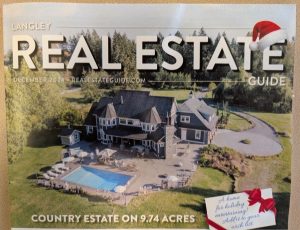Why Is This Still Happening?

OPINION, Michael Marrapese, March 2025
Several decades ago our local agricultural cooperative sold many of the products that active farms needed; fencing and metal products, lumber, farming tools and machinery, fuel and oil products, farm boots, heavy rain gear and work clothes. Today the farm equipment section is reduced to two aisles — mostly garden tools — and the lumber yard is gone. In their place are a food service counter, a fashion section, and a barber shop. This change represents a changing demographic throughout the Fraser Valley— fewer active farms, more residential properties.
Hundreds if not thousands of small farms in the Fraser Valley have been converted into lifestyle estates. While recent changes to the ALR regulations restricts house sizes to a maximum of 500 square meters (5,382 sq ft), until very recently municipalities continued to issue building permits on ALR land for homes in excess of 10,000 square feet. These properties will likely never be productive farms for generations.
Urban densification is putting pressure on municipal councils to change official community plans to expand the urban boundaries and to push for non-farm development of ALR land. At recent town council meetings in our area developers cleverly attempt to rebrand ALR land as “Employment Lands” claiming that a large warehouse or industrial facility creates more employment than working farms. They actively push for non-farm uses of farmland and to have farmland excluded from the ALR. They often quote the tired argument that these properties have poor soil. This is disingenuous as chickens, livestock, greenhouse operations, and vineyards can be productive on marginal soils.
 There is still dissatisfaction and disagreement from real estate professionals who argue that wealthy families should be allowed to build nice houses — by this they mean mansions — and suggest that it is only wealthy families can afford to purchase farmland and effectively arguing that farming as an economic activity is dead. Still, agriculture in the Fraser Valley contributes $2.4 billion in economic benefit to the provincial economy whereas lifestyle estates on 20 acres of farmland with tennis courts and swimming pools contribute very little.
There is still dissatisfaction and disagreement from real estate professionals who argue that wealthy families should be allowed to build nice houses — by this they mean mansions — and suggest that it is only wealthy families can afford to purchase farmland and effectively arguing that farming as an economic activity is dead. Still, agriculture in the Fraser Valley contributes $2.4 billion in economic benefit to the provincial economy whereas lifestyle estates on 20 acres of farmland with tennis courts and swimming pools contribute very little.
While the ALR has some ability to restrict development on land the Reserve, this alone has not had the desired affect of limiting speculation on rural and semi-rural properties. As property values rise throughout most agricultural regions in BC, so too has the purchase price of agricultural land. This is ultimately where free market capitalism is failing society. If farmland prices cannot be controlled, ultimately farming will be priced out of the Valley. The only adequate protection is to take farmland out of the speculative market and ensure it is accessible for farming.
Agricultural production and food security are the basis for any society. If a county cannot produce sufficient food to feed its citizens, they must purchase it from other countries. In a time when economic globalism is collapsing it is ever more imperative that we protect our agricultural land base. And yet, municipalities and developer continue to flaunt or at least circumvent ALR regulations.
Further Reading
https://www.producer.com/news/b-c-agricultural-land-reserve-advised-to-refocus/












